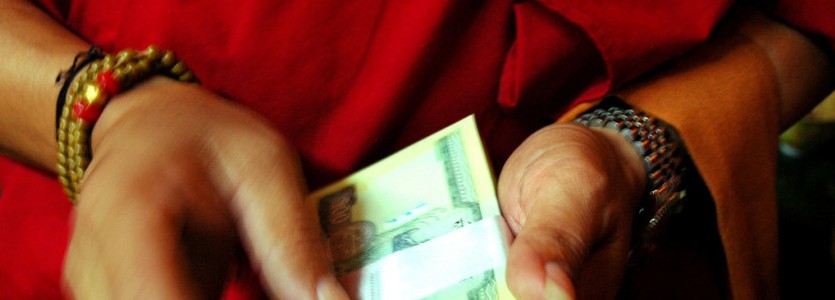Selling with an Eastern Mind

 This is a guest post from Nick Price, who offers a very different sort of business consultancy over at Of Things Immaterial. Some great food for thought here, and a big thanks to Nick for taking the time to write this for my blog.
This is a guest post from Nick Price, who offers a very different sort of business consultancy over at Of Things Immaterial. Some great food for thought here, and a big thanks to Nick for taking the time to write this for my blog.
When selling doesn’t feel natural
In the early stages of forming a business, or running one alone, we sometimes have to do things that do not come naturally to us. One that is often a problem is selling. There are many reasons why we may not feel comfortable selling things. One big reason for discomfort is that, unlike making a product or delivering a service, when it comes to selling, failure is part of success.
Not every opportunity we have to put something in someone else’s hands for a return will succeed. A sales opportunity may fail for any number of reasons. For example, our inability to communicate our worth, a lack of appreciation of our offer, a mismatch in timing of need or even a mismatch in the personalities involved can all lead to a missed sales opportunity. Setting aside the Sales Funnel idea, we’ll concentrate on the challenge of managing our feelings.
Rethinking our Selves not just our Skills
When we feel our value is in delivering something perfect, unique or better than someone else, integrating failure into our psyche can be a significant mindset shift. As much as we can invest in learning sales skills, working on our inner self, our interior will be an enabler.
I’m going to give you an insight from another very successful part of my career, that of business development. My manager at the time, Greg Kershaw, who had had a successful technology sales career with Hewlett-Packard in the Asia Pacific, gave it to me. It is an insight that comes from Eastern philosophy rather than Western thinking.
In Buddhism, much is made of the separation of the interior self from our exterior physical being. A gateway to seeing this separation, but not a prerequisite for the insight I am about to give you, is through meditation. For our purposes I want you to consider a simple position. Rather than seeing yourself as one entity, I suggest you think in terms of two: your True Self and your Manifest Self.
A Team of One (or Two), you
Your True Self represents your thinking and feelings. It also includes your ego, nature, values and beliefs. Your body and behaviour, on the other hand, compose your Manifest Self.
The purpose of this separation is to see your True Self as directing the Manifest Self. This separation gives you the ability for your True Self to direct the Manifest Self in behaviour that may be in conflict with your nature.
Why is this useful for our success in sales? The separation of the True Self and Manifest Self is useful in maintaining the selling mindset. Through your identification with your True Self, you can protect your ego from the feelings of failure experienced by the Manifest Self. In short, you can detach your True Self from emotional association with the activities of Manifest Self. This is particularly helpful for the perfectionist.
Adopting this mindset is not just about protecting the ego and dealing with perfectionism – it is also about expanding your strategic options.
Expanded options
Selling is a very human and personal activity. It is an activity of negotiated collaboration through the exchange of money for objects, services or experiences. In the very human ground of creating a transaction there can be pleasant experiences, but there are also often tense experiences involving conflict, pressure, bargaining, backing down, standing up, winning, losing and so on. These experiences can be very stressful (and/or exciting too!) for the ego.
Navigating these stressful experiences with the detachment afforded by a separated self, as discussed above, gives you the emotional space to step back. Being able to step back gives you the option of thinking strategically rather than just emotionally and reactively. Let’s think through a few of examples of activities in the sales process to see what that means:
-
- Losing a prospect. This can be a frustrating experience. An un-separated self might get stuck in the emotional deconstruction of the experience. The ego can become caught in self-judgement, descending into negativity, or even deciding not to care at all.
Through a separated self the True Self is able to dispassionately learn from the direction given to the Manifest Self. The True Self is also able to integrate the experience with an objective understanding of the complex and arbitrary nature of the selling process.
-
- Pricing. A submitted proposal is rejected because it is said to be too expensive. Our un-separated self may be disabled due to the disturbance of the ego. As a result, the self is too attached to winning to negotiate, feels hurt by the rejection and feels disrespected for the lack of recognition of the value of the offer.
A separated self, composed of the True Self and the Manifest Self, has more room to look at options. The True Self has separated the ego from the emotional disturbance caused by the rejection of the proposal delivered by the Manifest Self. It is emotionally distanced enough to dispassionately examine the reasons for rejection and can consider whether the rejection is simply a ploy or whether to look for alternative options, such as lowering the price and reducing the scope.
-
- Entertainment. Another part of selling, although possibly less prevalent nowadays, is the social aspect. If by nature you are an introvert then you might have already spotted the lifeline this separated self-model may give you. Without our model we have our un-separated self caught up in the angst of stumbling through a social event.
Acting with our True Self and Manifest Self model we can send someone else off to handle the social event for us. And do we know who that someone is? Yes, it’s us. Well, it’s our Manifest Self anyway. Our True Self can come along for the ride, and perhaps even make the Manifest Self experiment with a few goofy things that stretch our usual behaviour. Our ego is detached and protected in the True Self and learning.
Broken Self and Broken Responsibility?
On the flip side to this idea, of course, is the idea of responsibility. Haven’t we become irresponsible by splitting ourselves?
No. The True Self is always present and has values and boundaries within which to steer the Manifest Self. Here we have circled back to Buddhism – Zen Buddhism this time. We are holding two apparently conflicting truths simultaneously. A separated self, divided into True Self and Manifest Self, that is really oneself. You could almost say it’s the sound of a one-handed salesman clapping.
A Contemporary View
I learned this technique at the turn of the century, on the other side of the planet from the UK in Australia. Australia has long benefited from the presence of Eastern thinking since the waves of migration from Asia.
Since the time I came across it, mindfulness, yoga and meditation have become increasingly popular in the West. In addition, we are now integrating the idea of experimentation in business through concepts such as agile development. Experimentation is a key concept in the True Self, working in conjunction with, yet detachment from, the Manifest Self.
I hope that this model is useful for you. Initially, you may need to consciously practise it but, like many other ideas, it can eventually become second nature. I help people and businesses think creatively and about the longer term. In doing that I draw upon my experience in living and working for and with people from around the world. Integrating and considering different thinking styles from different cultures is an important part of my work.
More about Nick Price
I am a creative business consultant. I have a career spanning technology, business, design, user experience, strategy and future thinking. I work with organizations ranging from start-ups to multinationals. Clients use me to get a different view on their business, test if they’re going about things in the right way and find new ways to collaborate and think together. Now based in the UK I have worked around the world in technology and consulting in Australia, Philips Design in the Netherlands and Microsoft at their headquarters in Redmond, USA.
Website: ofthingsimmaterial.com About: ofthingsimmaterial.com/about Profile: www.linkedin.com
photo credit – not Nick Price, but a Buddhist monk giving out money, taken by Wonderlane and found on Flickr under a creative commons licence


